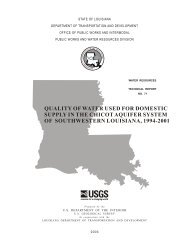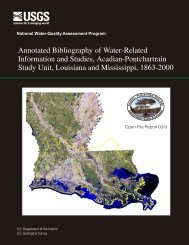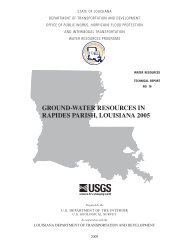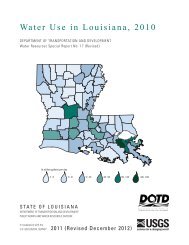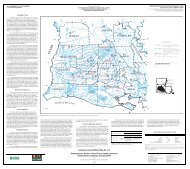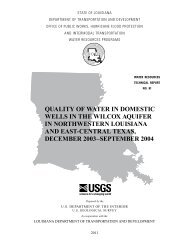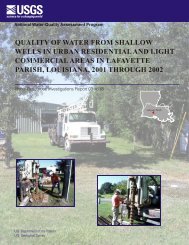environmental setting, water quality, and ecological indicators of
environmental setting, water quality, and ecological indicators of
environmental setting, water quality, and ecological indicators of
Create successful ePaper yourself
Turn your PDF publications into a flip-book with our unique Google optimized e-Paper software.
QUANTITY, IN MILLION GALLONS PER DAY<br />
500<br />
450<br />
400<br />
350<br />
300<br />
250<br />
200<br />
150<br />
100<br />
50<br />
0<br />
Aquaculture<br />
Ground Water<br />
Aquaculture<br />
Surface Water<br />
Rice Irrigation<br />
Ground Water<br />
Figure 5. Sources <strong>and</strong> quantities <strong>of</strong> <strong>water</strong> used in the Mermentau River Basin, southwestern Louisiana, 2000.<br />
<strong>and</strong> Bayou Queue de Tortue enters the river from the east.<br />
The five bayous divide the Mermentau River Basin into<br />
a series <strong>of</strong> broad, flat areas ideal for agriculture. These<br />
areas are separated by bottoml<strong>and</strong> hardwood riparian<br />
corridors that vary in width from only a hundred feet to<br />
several miles. L<strong>and</strong>-surface elevations are less than<br />
100 ft above NGVD 29 in most <strong>of</strong> the basin <strong>and</strong> less than<br />
25 ft above NGVD 29 along the Mermentau River mainstem.<br />
Thus, the Mermentau River Basin is characterized<br />
by a low gradient <strong>and</strong> dendritic river system that drains<br />
to the Gulf <strong>of</strong> Mexico.<br />
Hydrology in the Mermentau River Basin is complicated<br />
by the extensive use <strong>of</strong> ground <strong>water</strong> for irrigation<br />
<strong>and</strong> by modifications for agriculture <strong>and</strong> navigation.<br />
Water used to flood ricefields may enter the Chicot aquifer<br />
system, be reused downstream for agriculture, or<br />
drain to the Gulf <strong>of</strong> Mexico. During the study described<br />
in this report, a dam was constructed upstream from one<br />
<strong>of</strong> the long-term surface-<strong>water</strong> sites, Des Cannes,<br />
because a train derailed <strong>and</strong> spilled chemicals (National<br />
Transportation Safety Board, 2002). Modifications <strong>of</strong><br />
streams for navigation <strong>and</strong> <strong>water</strong>-control structures are<br />
common in the basin.<br />
The Mermentau River Basin is characterized by<br />
free-flowing streams in the north. The low gradient <strong>and</strong><br />
low topographic relief in the southern part <strong>of</strong> the basin<br />
create both bidirectional (downstream <strong>and</strong> upstream) <strong>and</strong><br />
interbasin flow, with <strong>water</strong> velocities typically less than<br />
10<br />
Rice Irrigation<br />
Surface Water<br />
WATER-USE CATEGORY AND SOURCE OF WATER<br />
Public Supply<br />
Ground Water<br />
1 ft/s. The river is tidally affected, <strong>and</strong> most upstream<br />
(negative) flow occurs in the summer <strong>and</strong> fall. Negative<br />
flow can be caused by natural events such as storms <strong>and</strong><br />
sustained winds from the south in conjunction with<br />
unusually high tides. These negative flows can be<br />
increased in magnitude <strong>and</strong> duration during low-discharge<br />
periods, such as occurred during the drought <strong>of</strong><br />
1999-2000 (fig. 6). Pumping <strong>of</strong> surface <strong>water</strong> for irrigation<br />
may cause bidirectional flow, but typically only in<br />
the smaller tributaries.<br />
The naturally low gradient <strong>and</strong> human-made canals<br />
<strong>and</strong> <strong>water</strong>ways allow interbasin flows. The primary flow<br />
route is the Gulf Intracoastal Waterway (GIWW), constructed<br />
in 1940 (fig. 3). The GIWW crosses the Mermentau<br />
River north <strong>of</strong> Gr<strong>and</strong> Lake <strong>and</strong> is a major route<br />
for east-west barge traffic along the Gulf Coast. A complex<br />
series <strong>of</strong> gates <strong>and</strong> locks is operated by the U.S.<br />
Army Corps <strong>of</strong> Engineers (USACE) to manage the<br />
<strong>water</strong>way. The GIWW hydraulically connects the Mermentau<br />
River Basin with the Calcasieu River Basin to the<br />
west <strong>and</strong> the Teche-Vermilion Basin to the east.<br />
In the 1970’s, the natural mouth <strong>of</strong> the Mermentau<br />
River was bypassed with the construction <strong>of</strong> a separate<br />
4.6-mi navigation channel from Lower Mud Lake to the<br />
Gulf <strong>of</strong> Mexico. This navigation channel, the GIWW,<br />
<strong>and</strong> other hydrologic modifications throughout southwestern<br />
Louisiana are managed by numerous <strong>water</strong>-control<br />
structures. One such structure on the Mermentau



